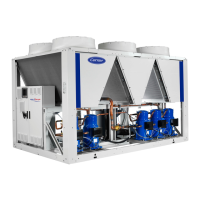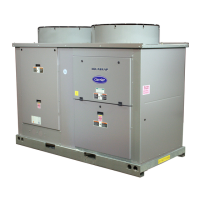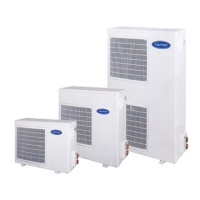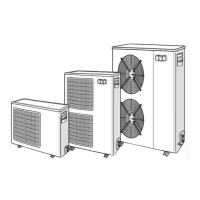8
4.2.1 - Description
The unit start/stop can be controlled by one of the following
methods:
• Locally on the actual unit (Local control type)
• By remote control with the aid of user contacts (remote
control type)
• By CCN control with the aid of the CCN (CCN control
type)
The main interface includes a Start/Stop button which can
be used to stop or start the unit in the local operating type
or to select the remote or CCN operating type.
The available operating types are described in the following
table.
The following operating types can be selected using the
Start/Stop button:
LOFF The unit is halted in local mode.
L-On The unit is in local control mode and is authorised to start.
L-Sc* The unit is in local control mode. It is
authorised to start if the period is occupied. If the timer program for
unit operation is unoccupied, the unit remains shut down until the
period becomes occupied.
CCN The unit is controlled by CCN commands.
rEM The unit is controlled by remote control contacts.
MAST* The unit runs as a master in a two unit lead/lag
arrange-ment. This is displayed if the unit is congured for master/
slave control.
* Displayed if the conguration requires it.
Section 5.1 gives a more detailed description of the commands to start/stop
the unit, analysed by operating type.
4.2.2 - Stopping the unit in local mode
The unit can be stopped in local mode at any time by
pressing the Start/Stop button.
Press the Start/Stop button for
less than 4 seconds (one short
press is enough).
C LOFF
If the button is released, the unit
stops without the need for further
action.
t LOFF
4.2.3 - Starting unit and selecting an operating type
The unit can be started in local mode, or unit operating
type can be changed at any time using the Start/Stop
button. In the example that follows, the unit is stopped
(LOFF) and the user wants to start the unit in local mode.
The summary interface (right hand section) includes a mimic
diagram of the unit, together with push-buttons and LEDs.
It gives quick access to the main operating parameters of
the unit.
:
The unit is authorised to start or is already running
- Lit: circuit A or unit shut down by alarm
- Flashing: circuit A or unit running with alarm present
- Lit: circuit B or unit shut down by alarm
- Flashing: circuit B or unit running with alarm present
- Lit: circuit C or unit shut down by alarm
- Flashing: circuit C or unit running with alarm present
The evaporator pump is running.
From top to bottom - start/stop status of compressor A1, A2, A3 and A4
or B1, B2, B3 and B4 or C1, C2, C3 and C4. Flashing LED indicates that
the circuit is in the protection or defrost mode (A, B or C).
The unit operates in heating mode.
The unit operates in cooling mode.
Blue button: evaporator leaving or entering water temperature in °C
Gray button: outdoor air temperature in °C
Control point (setpoint + reset) in °C
Press 1: circuit A/B discharge pressure in kPa
Press 2: circuit A/B saturated condensing temperature in °C
Press 1: circuit A/B suction pressure in kPa
Press 2: circuit A/B saturated suction temperature in °C
Press 1: compressor A1/B1 operating hours in h/10 or h/100
Press 2: compressor A2/B2 operating hours in h/10 or h/100
Press 3: compressor A3/B3 operating hours in h/10 or h/100
Press 4: compressor A4/B4 operating hours in h/10 or h/100
(1) There is a separate button for each of the two circuits.
Blue button: evaporator leaving or entering water temperature in °C
Gray button: outdoor air temperature in °C
Control point (setpoint + reset) in °C
Press 1: circuit A/B/C discharge pressure in kPa
Press 2: circuit A/B/C saturated condensing temperature in °C
Press 1: circuit A/B/C suction pressure in kPa
Press 2: circuit A/B/C saturated suction temperature in °C
Press 1: compressor A1/B1/C1 operating hours in h/10 or h/100
Press 2: compressor A2/B2/C2 operating hours in h/10 or h/100
Press 3: compressor A3/B3/C3 operating hours in h/10 or h/100
Press 4: compressor A4/B4/C4 operating hours in h/10 or h/100
Press 1: Selects circuit A to display information
(only on triple-circuit units)
Press 1: Selects circuit B to display information
(only on triple-circuit units)
Press 1: Selects circuit C to display information
(only on triple-circuit units)
(1) There is a common button for the three circuits; for circuit selection press one
of the three last buttons described above.
(1)
(1)
(1)
AA
AA
AA
B
AA
C
(1)
(1)
(1)

